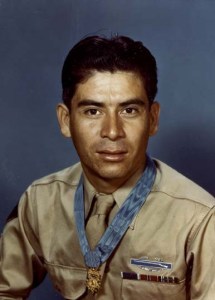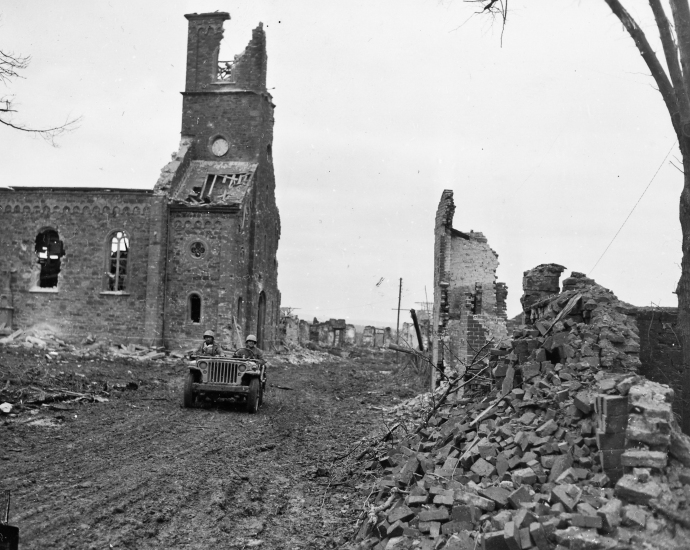Grosshau, Germany
Eastern Edge of the Hurtgen Forest
Cold, wet and hungry Soldiers hunkered down in foxholes, side by side with complete strangers. In two weeks, the 22nd Infantry had lost 151% of its riflemen while fighting for six thousand yards of ground in the Hurtgen Forest. Urged forward time after time, the line companies had endured an onslaught of German artillery barrages, machine gun fire and minefields. Many attacks had been stopped cold, smothered by German shells and bullets. So many men had been lost that the rifle companies were filled with green replacements thrown into the line with bewildering speed. Once considered the pride of the 1st Army, the 22nd had become a shell of its former self.
The attacks continued with relentless intensity until the 22nd Infantry had lost almost all its veteran dogfaces, the men who had come ashore at Utah Beach earlier in the summer. Somehow, the regiment ground forward, inch by inch against withering fire and counter-attacks until by the end of November, one of the 22nd Infantry’s battalions had reached the outskirts of Grosshau, Germany, the last town before the Roer Plain. Take the town and another push would thrust the entire 4th Infantry Division into open ground where the 5th Armored Division, waiting in reserve, would exploit.
 On November 27, 1944, B Company 1st Battalion 22nd Infantry advanced into a German kill zone while pushing on for Grossau. Pinned down by machine gun fire, B Company was soon hit by an artillery and mortar barrage. With casualties mounting, an acting squad leader named Private Marcario Garcia launched a one-man attack on the machine gun nest. Despite being wounded, he pressed his assault, killed three Germans and knocked out the machine gun. He returned to the company line, which was now being raked by another machine gun nest. He located it and stormed the nest, killing three more Germans and capturing four others. The second attack freed up B Company and the advance continued. Only then did Garcia go to the rear for medical treatment.
On November 27, 1944, B Company 1st Battalion 22nd Infantry advanced into a German kill zone while pushing on for Grossau. Pinned down by machine gun fire, B Company was soon hit by an artillery and mortar barrage. With casualties mounting, an acting squad leader named Private Marcario Garcia launched a one-man attack on the machine gun nest. Despite being wounded, he pressed his assault, killed three Germans and knocked out the machine gun. He returned to the company line, which was now being raked by another machine gun nest. He located it and stormed the nest, killing three more Germans and capturing four others. The second attack freed up B Company and the advance continued. Only then did Garcia go to the rear for medical treatment.
Private Garcia received the Medal of Honor for his actions that day, the first Mexican citizen to receive America’s highest award for bravery. He became an American citizen in 1947. Shortly after President Truman bestowed the MOH on him at a White House ceremony in 1945, Garcia tried to order food at a restaurant south of Houston, Texas. The owner refused to serve him because he was Hispanic. When Garcia protested, the owner beat him with a baseball bat. Walter Winchell later reported on the incident, and Garcia’s beating became a rallying point for Latino-Americans.
On the 29th, 3rd Battalion, 22nd Infantry fought its way into Grosshau with the help of a platoon of tanks. The Germans defending the town refused to surrender, and the fighting devolved into point-blank building-to-building battles. Grossau, which had been subjected to countless barrages of American artillery, was almost completely destroyed in the fighting. Germans held out in cellars and within the ruins until nightfall, but the 3rd Battalion eventually cleared them out and secured the town.
 One more push and the regiment would clear the Hurtgen Forest and break into the open ground beyond. The regiment was ordered forward, reinforced by the 46th Armored Infantry Battalion, the regiment tried to clear the Hurtgen on the 30th. Little progress was made beyond reaching the woodline on the far side of Grosshau.
One more push and the regiment would clear the Hurtgen Forest and break into the open ground beyond. The regiment was ordered forward, reinforced by the 46th Armored Infantry Battalion, the regiment tried to clear the Hurtgen on the 30th. Little progress was made beyond reaching the woodline on the far side of Grosshau.
On the 1st, 2-22 and the 46th tried again. The men ran into a massive German artillery barrage that pinned them down and savaged their ranks. The Germans counter-attacked and flung the 2nd Battalion back. The Germans were stopped only when the battalion’s reserves were thrown into the fight. By the end of the day, 2-22 was down to a hundred and twenty-five men.

On of the 22nd Infantry’s 81mm mortar crews firing in support of the rifle companies holding off a German counter-attack at Grosshau on December 1, 1944.
Colonel Charles T. Lanham, the 22nd’s commanding officer, saw that his men had nothing left to give. With his battalions down below company strength and the Germans massing on his northern flank for another counter-attack, he organized a scratch force composed of headquarters troops and supply clerks. That gave him a hundred man reserve.
Lanham was a highly regarded officer who’d been with the 22nd since Utah Beach. Known for his grit, he was also a warrior-poet and short story writer. Ernest Hemingway befriended him that fall while the 22nd fought its way through the Siegfried Line and later described him as, “The finest and bravest and most intelligent military commander I’ve ever known.”
The Germans hit Lanham’s 3-22 the next day in a furious counter-assault. The onslaught was too much for the battalion, and one skeletal company was overwhelmed. The Germans poured into the regiment’s rear, hitting both the headquarters of 1st and 3rd battalions. Lanham ordered his men to hold on and keep fighting. He threw in his scratch reserves, supported by a few tanks. They contained the German breach, cleared it and restored the line.
That night, the 4th Infantry Division commander, Major General Raymond Barton, sent in a regiment from the 83rd Infantry Division to effect a relief in place. As it was underway, the Germans hit the 22nd again and overran part of 1-22. Again, headquarters troops and a few men from a heavy weapons company contained the German attack and eventually threw it back. Later that day, as the 22nd was pulling out, about thirty Luftwaffe fighter-bombers made a final, parting attack on the regiment. Fortunately, the trees that had sheltered the German defenders from American air power returned the favor for the 22nd that day, and few men were hit in that last crucible in the Hurtgen Forest.
In eighteen days of close quarters combat among the woods and hills of the Hurtgen, the 22nd Infantry suffered 2,773 casualties. They’d gone in with a total strength of about 3,200 men. Everyone suffered, not just the line units. In the Hurtgen, there were no rear areas, only targets for German long-range artillery. During the battle, Lanham’s men captured 762 German soldiers. They had advanced six thousand yards and had taken their main objective despite some of the worst terrain and most formidable defenses the U.S. Army encountered in Europe during World War II.



